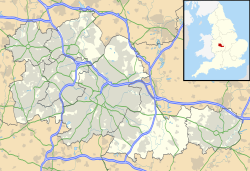BBC Birmingham and BBC Midlands, from their initial conception, were to provide local interest and national programme output for the Midland Region. Over Pebble Mill's 35 years of operation the studios produced some of the BBC's most iconic programmes and was second to Television Centre for total output. The following is a small list of the total programme output of the complex. There were many single and short run documentaries, OBs and pilots which have come and gone over the years many of which will never be remembered.
Radio
Pebble Mill housed Radio West Midlands (Radio WM) but also produced programming for Radio 2, 3 and 4. Most of Radio 4's 1990s dramas came from Pebble Mill. Radio programming included over the years Woman’s Hour , The Ed Stewart Show on Sunday afternoons. The Richard Bacon Show, live Saturday and Sunday nights on Radio 5. Radio 2’s specialist popular music shows such as Best of Jazz, Paul Jones, Stuart Maconie’s Critical List and Radio 2's Through the Night, presented by Janice Long, Alex Lester and Mo Dutta. The world's longest running radio soap, The Archers , was produced in Studio 3.
Television
News and documentary
News and documentary programming included Midlands Today , the midlands region news programme, Inside Out , Points of View , and The Chequered Flag, about the history of motor sports. The John Gau Productions/CBS/TBS coproduction Reaching For the Skies was a documentary series on the history of aviation. Also in the 1990s a news department programme, The Midlands at Westminster, a local politics strand, broadcast at Sunday lunch time on BBC 2.
Light entertainment
Light entertainment included Telly Addicts , Top Gear Motorsport , Noel's Addicts, The Great Egg Race with Professor Heinz Wolff, a series of 2point4 Children , An Actors Life, The Golden Oldie Picture Show, May to December , Don't Wait Up , Going for a Song (the 1990s version) and Call My Bluff (1997–2005 revival). It also included Can't Cook Won't Cook , A Song for Christmas, The Basil Brush Show (1970s version) and Best of Brass, a brass band competition.
Drama
Throughout its 35-year history Pebble Mill productions of BBC drama was extensive.
Morgan's Boy, Rose for Winter, Jane Eyre, Fosdyke Saga , Airbase, Tycoon, Bird of Prey , and A Very Peculiar Practice (first series). Owen MD, Lord Peter Wimsey played by Ian Carmichael, and Diary of a Madman. Episodes of Z-Cars , The Moonstone , The Roses of Eyam , Prometheus, Sophia and Constance , Second City Firsts , The Battle of Waterloo starring Warren Clarke, Poldark , Martin Chuzzelwit , and Angels , Shakespeare plays, Dalziel and Pascoe , and Vanity Fair (1987).
Soap operas and serials
A series of Pobol Y Cwm in the early 1970s, Doctors , Dangerfield , Trainer , Kinsey , Triangle , Doctor Who serial Horror of Fang Rock in 1977, [6] All Creatures Great and Small , Howards' Way , Juliet Bravo , This Life , The Brothers starring Jean Anderson, and Spy Trap . Pebble Mill produced Specials a short series about a group of Special Police Officers in a fictional Midlands town. and the anthology series The Afternoon Play.
Asian Unit
During the early 1960s BBC Birmingham pioneered television programmes for the Asian community. These were presented and produced by Mahendra Kaul, directed by Ashok Rampal and broadcast on Sunday mornings. Apna Hi Ghar Samajhiye ("Make Yourself At Home") aired on Sundays at 9 am for half an hour. Empire Road (1978–79), written by Michael Abbensetts was a drama series about the African Caribbean and Asian communities which was shown on BBC 2. During the late '70s and '80s Network East was produced in Studio A and B, consisting of music and interviews.
Daytime television
BBC Birmingham utilised the main foyer of Pebble Mill for television entertainment and magazine programmes, mostly for BBC1. One fixture of the schedule, Pebble Mill at One was an early afternoon show, though it started originally on BBC2. The idea to use the reception and foyer for programmes was borne out of the fact, all the other studio space were either fully used for Birmingham produced, or for BBC TV's network needs for the various London based programme departments. Pebble Mill at One ran from 1972 until 1986, was then one of few daytime magazine programmes, hence its success at the time.
There was at least one Pebble Mill spin-off during the 1970s, when BBC1 rested its main Saturday chat show, Parkinson . BBC Birmingham was commissioned to produce a late night chat show. Saturday Night at the Mill, was the result and Kenny Ball and his Jazzmen were the regular house band; they performed the show's signature tune. The programme was directed and produced in Birmingham by Roy Norton and Roy Ronnie. In 1981 an early evening version of a hit BBC1 show from the sixties called Six Five Special resurfaced during the Mill's summer break, presented by Donny MacLeod and Marian Foster.
The Pebble Mill format returned in 1988 as Daytime Live, renamed Scene Today, and followed by Good Morning with Anne and Nick , both broadcast from Studio C. Pebble Mill was resurrected in 1991 and aired from Studio A, presented by Alan Titchmarsh and Judi Spiers in a format similar to Pebble Mill at One.




